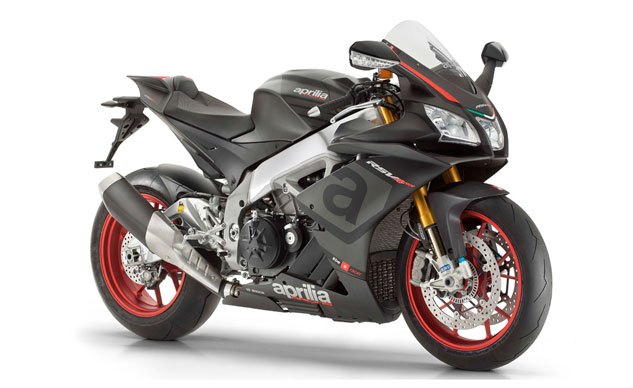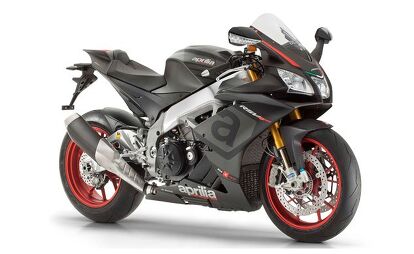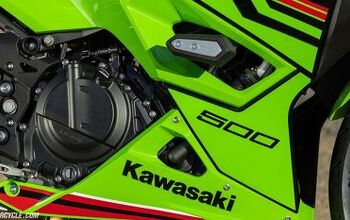2014 EICMA: 2015 Aprilia RSV4 RR and RF Preview

Just days after claiming both the rider and manufacturer titles in World Superbike, Aprilia has unleashed the new RSV4 RR on the motorcycling public. Winning seven world titles in six years more than establishes Aprilia as a manufacturer that knows how to build supersport motorcycles. The RSV4 RR capitalizes on that experience to up the track-focused battle for dominance.
Claiming that the RR is “most important and profound advancement ever made” to the RSV4, Aprilia managed to massage a claimed increase of 16 hp out of an engine that is 3.3 lb. lighter than the previous generation 65° V-Four – pushing the output to 198.5 hp at 13,000 rpm with 84.8 lb-ft. at 10,500 rpm. Aprilia engineers redesigned almost all of the engine’s internals to reduce friction and improving combustion efficiency. The new air box is designed to maximize pressure in the intake ducts via reduced air flow losses through the use of Computational Fluid Dynamics which placed the air filter perpendicular to the direction of flow. Each bank of cylinders receives a servo dedicated to only the two throttlebodies on that bank. New upper injectors feed into variable length intake ducts with a wider range of travel.
The fuel mixture flows through redesigned CNC milled heads. The combustion chamber is also “no longer obtained through a fusion process but by a finer mechanical process which is also numerically controlled.” The height of valve seat seals was increased for better reliability and function at elevated rpm. Valve timing is controlled by a combination of chain and gears, having the intake cam powered by the chain while the exhaust being gear-driven off the intake cam. In order to reduce the parasitic drag within the top end, all rotating parts were lightened. (For example, the intake cam was lightened by 500 grams.) The lightening continued with the use of titanium valves – with the intake valves bumping up to 33mm. Another new feature is the oval section valve springs used on the intake side.
The crankshaft’s connecting rod pins were reduced to 36mm, and the Pankl connecting rods tip the scales at 400 grams less than last year. The crankcase retains its mono bloc design with aluminum cylinder liners, while the top half of the case has been lightened and strengthened through a “new shell fusion.” Improved crankcase ventilation reduces pumping power losses. A new oil sump consistently feeds the redesigned lubrication system regardless of engine orientation. The entire exhaust system has been updated in addition to the improved electronic valve management. A more powerful ECU controls the power production while the transmission uses new ratios to feed the increased power to the pavement.
Chassis architecture remains unchanged – still adjustable is the engine position (stock positioning is in the lowest setting), headstock angle, swingers pivot and rear ride height – but the swingarm was lengthened 14mm to help decrease the bike’s tendency to wheelie during hard acceleration.
The Aprilia Performance Ride Control (aPRC) system has been recalibrated to provide easier on-the-fly traction control adjustment, more effective wheelie control and launch control, as well as clutchless upshifting with Aprilia Quick Shifter. In addition to the second generation aPRC system, the RSV4 RR comes from the factory standard with a Bosch Race ABS system.
In addition to the Superpole color scheme, the RSV4 RR comes in a matte Bucine grey and matte black Ascari. Availability and pricing were announced at the time of publication.

Like most of the best happenings in his life, Evans stumbled into his motojournalism career. While on his way to a planned life in academia, he applied for a job at a motorcycle magazine, thinking he’d get the opportunity to write some freelance articles. Instead, he was offered a full-time job in which he discovered he could actually get paid to ride other people’s motorcycles – and he’s never looked back. Over the 25 years he’s been in the motorcycle industry, Evans has written two books, 101 Sportbike Performance Projects and How to Modify Your Metric Cruiser, and has ridden just about every production motorcycle manufactured. Evans has a deep love of motorcycles and believes they are a force for good in the world.
More by Evans Brasfield







































Comments
Join the conversation
"Computational Fluid Dynamics which placed the air filter perpendicular to the direction of flow" -- .. imagine if these geniuses had placed the filter parallel to the direction of flow.. That they needed CFD to come up with the obvious is the amazing thing here, though I think this write-up was done purely by marketing nincompoops.
I'm not buying any of these 200HP rumors until I see them on the dyno and what the rear wheel says! Ducati especially always jack their HP numbers through the roof only to make significantly less than claimed. So we have 205HP 1299Pani, 200HP YZF R1, 200HP BMW S1000RR and now the RSV4 makes 199HP??? I bet money the S1000RR will still win the HP war easily when the dyno is fired up.